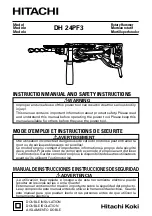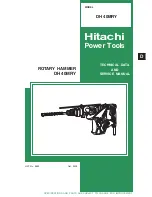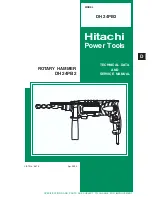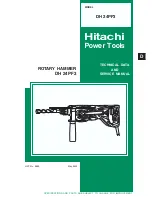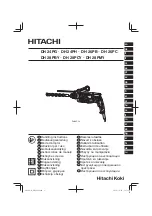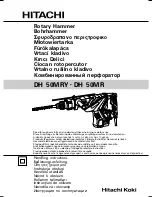
9 ENGLISH
NOTE:
Use a dry cloth to wipe the dirt off the lens of
the lamp. Be careful not to scratch the lens of lamp, or
it may lower the illumination.
Reversing switch action
►
Fig.5:
1.
Reversing switch lever
CAUTION:
Always check the direction of
rotation before operation.
CAUTION:
Use the reversing switch only after
the tool comes to a complete stop.
Changing the
direction of rotation before the tool stops may dam
-
age the tool.
CAUTION:
When not operating the tool,
always set the reversing switch lever to the neu-
tral position.
This tool has a reversing switch to change the direction
of rotation. Depress the reversing switch lever from the
A side for clockwise rotation or from the B side for coun
-
terclockwise rotation.
When the reversing switch lever is in the neutral posi-
tion, the switch trigger cannot be pulled.
Selecting the action mode
NOTICE:
Do not rotate the action mode chang-
ing knob when the tool is running.
The tool will be
damaged.
NOTICE:
To avoid rapid wear on the mode
change mechanism, be sure that the action mode
changing knob is always positively located in one
of the action mode positions.
Rotation with hammering
For drilling in concrete, masonry, etc., rotate the action
mode changing knob to the
symbol. Use a car-
bide-tipped drill bit.
►
Fig.6:
1.
Action mode changing knob
Rotation only
For drilling in wood, metal or plastic materials, rotate
the action mode changing knob to the symbol. Use a
twist drill bit or wood drill bit.
►
Fig.7:
1.
Action mode changing knob
ASSEMBLY
CAUTION:
Always be sure that the tool is
switched off and the battery cartridge is removed
before carrying out any work on the tool.
Side grip (auxiliary handle)
CAUTION:
Always use the side grip to ensure
safe operation.
CAUTION:
After installing or adjusting the
side grip, make sure that the side grip is firmly
secured.
Install the side grip so that the grooves on the grip fit in
the protrusions on the tool barrel. Turn the grip clock
-
wise to secure it. The grip can be fixed at desired angle.
►
Fig.8:
1.
Side grip
Grease
Coat the shank end of the drill bit beforehand with a
small amount of grease (about 0.5 - 1 g).
This chuck lubrication assures smooth action and lon
-
ger service life.
Installing or removing drill bit
Clean the shank end of the drill bit and apply grease
before installing the drill bit.
►
Fig.9:
1.
Shank end
2.
Grease
Insert the drill bit into the tool. Turn the drill bit and push
it in until it engages.
After installing the drill bit, always make sure that the
drill bit is securely held in place by trying to pull it out.
►
Fig.10:
1.
Drill bit
To remove the drill bit, pull the chuck cover down all the
way and pull the drill bit out.
►
Fig.11:
1.
Drill bit
2.
Chuck cover
Depth gauge
The depth gauge is convenient for drilling holes of
uniform depth. Loosen the side grip and insert the depth
gauge into the hole on the side grip. Adjust the depth
gauge to the desired depth and tighten the side grip
firmly.
►
Fig.12:
1.
Hole
2.
Depth gauge
NOTE:
Make sure that the depth gauge does not
touch the main body of the tool when attaching it.
Dust cup (optional accessory)
Use the dust cup to prevent dust from falling over the
tool and on yourself when performing overhead drilling
operations. Attach the dust cup to the bit as shown in
the figure. The size of bits which the dust cup can be
attached to is as follows.
Model
Bit diameter
Dust cup 5
6 mm - 14.5 mm
Dust cup 9
12 mm - 16 mm
►
Fig.13:
1.
Dust cup
Summary of Contents for DHR171RFJ
Page 2: ...1 2 3 Fig 1 1 2 Fig 2 1 Fig 3 1 2 Fig 4 1 A B Fig 5 1 Fig 6 1 Fig 7 1 Fig 8 2 ...
Page 3: ...1 2 Fig 9 1 Fig 10 1 2 Fig 11 1 2 Fig 12 1 Fig 13 1 2 Fig 14 Fig 15 1 Fig 16 3 ...
Page 4: ...1 2 Fig 17 1 Fig 18 1 2 Fig 19 1 Fig 20 Fig 21 1 2 3 1 2 3 Fig 22 4 ...



























